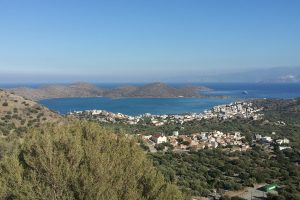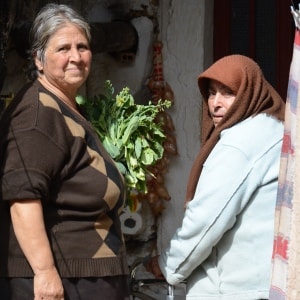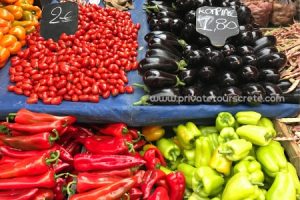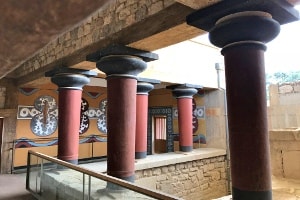Crete, the island of history and legend
Εsta página en español – Bu sayfanın Türkçesi – Η σελίδα αυτή στα ελληνικά
The island
Crete is located between Europe, Asia and Africa and is the southernmost part of Europe. It is the largest island in Greece, boasting more than 1,500 villages. The scenery is breathtaking and the beaches are endless. In addition, we have 300 days of sunshine per year! With a varied landscape, delicious and renowned local cuisine, unique flora, magnificent gorges, picturesque old cities and imposing mountains you will never get bored. Since the distances on the island are quite short, the visitor can get the most of the place. We should bear in mind that one visit here will never be enough, because there will always be new places for you to discover.

Natural Environment
Crete lies in the heart of the East Mediterranean basin. Mountains reaching higher than 2400 meters (7900 feet), numerous plateaus and the surrounding Cretan and Libyan seas create a variety of landscapes affecting the climate, vegetation, flora and fauna, as well as the Cretan way of life. Gorges and a large number of caves also provide a natural refuge for many endemic plant and animal species such as the Cretan dittany and the Cretan wild goat. Trails belonging in the European network of natural protected areas or less known footpaths are the perfect way to see and feel the nature of Crete.

The Cretans
The mountainous terrain of the island, the mild climate, the sunny weather and the generous land have forged the character of its inhabitants. The people are proud, openhearted, easygoing, tolerant and great lovers of freedom. Cretan hospitality is a unique experience, which unfortunately won’t be included in any of the packages offered in the market of mass tourism today. It’s also very important to mention that despite the unprecedented economic and industrial growth, the Cretan has managed to keep his traditions and culture intact. Cretan tradition has very deep roots in the past and expresses itself through popular art, local events, legends, music. It can be easily sensed everywhere by those who really want it. Wonderful embroidery, glass making, jewelry making and pottery are sure to fascinate everyone.

Products of the land
Crete is blessed with a wonderful nature, a moderate Mediterranean climate and fertile soil. Its products are of exceptional quality include excellent wine and olive oil of the finest quality in the world. In addition, you can find plenty of fruits, vegetables, and indigenous wild herbs with medicinal properties. All of the above find an excellent use in the famous Cretan cuisine, which is certified to promote health and longevity. During your stay don’t forget to try the best water in the world!

Mythology
According to the Greek mythology, Crete is the birthplace of Zeus, father and king of the Gods. It was in Crete that Zeus decided to seduce Europa, a princess of Phoenicia, giving her name to the entire continent. Their son Minos became the legendary king of Crete, ruling from the palace of Knossos, the maze-like architecture which inspired the legend of the Labyrinth. The legend has it that a bull-headed creature, which fed on human flesh, Minotaur, lived there in captivity, prisoner of king Minos. The Labyrinth also became the prison of its architect Daedalus and his young son Icarus, who managed to escape from there using wings, made of wax, thus becoming the first people who succeeded to fly.

History
Crete is the cradle of the Minoan Civilization, the first sophisticated civilization in Europe. Greeks, Romans, Byzantines, Arabs, Venetians and Ottoman Turks have left their mark on the island. This place has been the meeting point and melting pot of ideas, civilizations and trends for thousands of years. The visitor of Crete can see innumerable monuments that indicate the ceaseless line of history. This line goes back to 7,000 BCE. Crete is a true and unique time capsule. Besides the impressing Minoan palaces, ancient Greek and Roman antiquities, there is much more to see. There are hundreds of Byzantine churches, Venetian houses, fortifications and castles. In the towns you can find Ottoman mosques, fountains and Synagogues. Moreover, in the hundreds of the traditional villages you can still see the old way of life. As a result, history is constantly unrolled before the eyes of the visitor.
…and there is so much more! The options offered to someone visiting the island are vast. This calls for a good planning and preparation on the part of the traveler. In this you are not alone! I will be happy to assist you in any way possible.